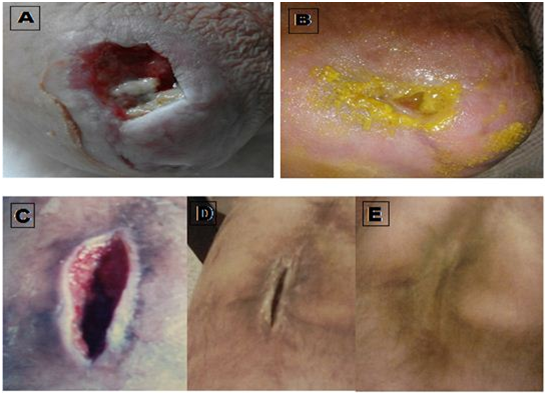MOJ
eISSN: 2379-6294


Case Report Volume 3 Issue 2
CIETO, Croatia
Correspondence: Bratko Filipic, CIETO, Koledinecka 3, 10040 Zagreb, Croatia, Tel 3865 1847 948
Received: May 20, 2017 | Published: June 16, 2017
Citation: Filipic B, Mazija H. Bee product apiderm royal gel® in pressure injuries and wound care - case report. MOJ Toxicol. 2017;3(2):44–45. DOI: 10.15406/mojt.2017.03.00050
Described are two cases of wound healing using gel composed of different types of bee pollen, water soluble propolis and different types of honey. Case I describes deep decubitus wound of heel in 91 years old patient. The bee product Apiderm royal gel® applied directly to the open wound was extremely effective in its healing. Already in 13 days the wound was almost closed and regenerative tissue completely developed 14 days later. The same product used for healing three years old mechanical wound (Case II) was the same successful. Previous surgical or antibiotic treatment did not help at all. After the bee product was applied the wound start healing immediately, and 11 days later it was almost closed with healing process completed seven days later.
Keywords: pressure injuries, wound, healing, bee product
Bee products are known for thousands years for its beneficial effect on wound healing process.1,2 Its effectiveness is partly explained only in recent years explaining the multiple bioactivities involved in healing process. It seems that the most important activity of bee products is acidification that promotes healing of deep wounds.3 Similar report was given by M phande et al.4 who reported on positive effects of honey and sugar dressing on wound healing. Part of the bee product activity in healing process could be addressed to its strong antibacterial activity directed even to multiresistant strains of bacteria.5 Honey was also used in treatment of decubitus ulcers.6 It is obvious that different bee products can act very positive to the healing process in both mechanical wounds as well as to the pressure wounds.7
Pressure injuries (decubitus) represent a significant problem in patient forced to ley in hospitals during or after surgical intervention or in phase of convalescence. Specific body region exposed are those where bones are close to the skin and support the organism constitution (heels, sacral region, shoulders), and are specific problem in elddery people. Wounds are very often difficult to heal if are infected and deep in muscular or connectivetissue, appearing after the skin is already destructed. Almost 83% to 87% of decubiti lesion are of hospital origin, and in stage II and III the prognosis is negative leading to chronic invalidities or finally in death of the patient. Treatment of wounds is difficult and time consuming with minimal improvement. It is related to complex mechanical treatment of wounds using air fluidized bed, hydrocolloid dressing, radiant heat dressing, electrical stimulation, electromagnetic therapy, negative pressure therapy, light therapy, laser therapy and much more as it is described in clinical guidelines.8
In this respect the use of Apiderm royal gel represents a novel approach. The gel is composed of different types of bee pollen, water soluble propolis of different types and mixture of different types of honey. The process of Apiderm royal gel® production includes thermal treatment of some of ingredients which is intelectually protected property.
Case I
Female patient aged 91 year because of improper treatment (not turning every two hours) gradually after one month developed decubitus wounds in both heels. Surgical treatment did not lead to the improvement of the lesion (Figure 1).

Figure 1 Before use of the gel the wound was 6 cm deep and 5 cm in diameter
Case II
Male 55 years old was wounded in severe car accident.
Efforts to improve the healing process of decubitus or mechanical wounds is a permanent duty of specialist in hospitals and relevant institution trying to reduce suffering of patients and also of those responsible for the economic cost of treatment of it. Actual approaches in that sense are directed to the mechanical support of circulation and using of different tools to alleviate the suffer of patient by surgical treatment, and use of antimicrobial substances.8 The bee product is Apiderm royal gel® acts directly to the wound healing process regard less of it’s ethnology acting at the same to the decubitus wound as to the mechanical once. It acts even in necrotic milieu as it is described by.6 It could be mentioned that the activity of Apiderm royal gel® is also antimicrobial one as described for different bee products.9,10
The presented “Case report” was supported by CRODUX, 10000 Zagreb, Croatia.
The author declares no conflict of interest.

©2017 Filipic, et al. This is an open access article distributed under the terms of the, which permits unrestricted use, distribution, and build upon your work non-commercially.